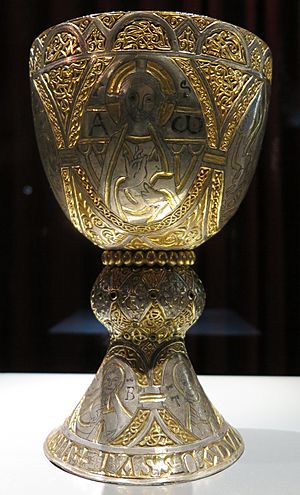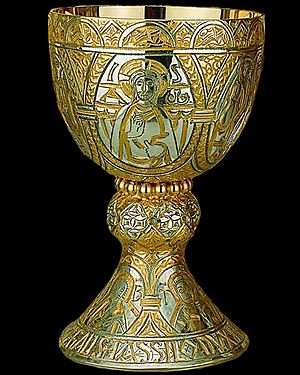Tassilo Chalice facts for kids
The Tassilo Chalice is a special cup made of bronze. It is covered with shiny silver and gold. This ancient chalice was created in the 8th century AD. It has a unique design from the Anglo-Saxons, a group of people who lived in England long ago. The chalice has likely been kept at Kremsmünster Abbey in Austria since it was first made.
Contents
What is the Tassilo Chalice?
The Tassilo Chalice is a very old and beautiful cup. It was made between 770 and 790 AD. It was given as a gift by Liutperga, who was the wife of Duke Tassilo III of Bavaria. They might have given it when the Benedictine Abbey at Kremsmünster was started in 777 AD.
How Was the Chalice Made?
The chalice has three main parts:
- An egg-shaped cup at the top.
- A large, decorative knob in the middle.
- A narrow base or foot at the bottom.
It is made from bronze. This bronze was then covered with gold and silver. Artists used different ways to decorate it. They used a technique called niello engraving, which adds black lines to metal. They also used chip-carving, which involves cutting small chips from the surface. The chalice is about 25.5 centimeters (10 inches) tall. It weighs 3.05 kilograms (about 6.7 pounds). The cup can hold about 1.75 liters (almost half a gallon) of liquid.
What Decorations Are on the Chalice?
The cup has oval shapes linked together. Inside these shapes, you can see a picture of Christ. His initials, "I" and "S," stand for Iesus Salvator (Jesus the Savior). There are also pictures of the four Evangelist portraits. Each of these Evangelists has their special symbol.
Around the base of the chalice, there are images of the Virgin Mary and John the Baptist. There is also a picture that some believe is of Queen Theodolinda from the Lombards. Most of the chalice is covered in interlace patterns. These are complex woven designs, and some even include small animal figures. Around the foot, there is a Latin message: "TASSILO DUX FORTIS + LIVTPIRG VIRGA REGALIS." This means "Tassilo the Brave Duke + Liutpirg the Royal Branch."
Where Did the Chalice Come From?
The Tassilo Chalice is a truly special and original piece of art. It might have been made by skilled workers from Northumbria, a kingdom in old England. Its decorations show a style called Hiberno-Saxon ornament. This style was popular during that time. It mixes Anglo-Saxon and Irish art. The chalice's style looks more like Anglo-Saxon art than Irish art.
Some monks during that period were also trained as goldsmiths. For example, Saint Dunstan, who was an Archbishop in the 10th century, was a goldsmith. Salzburg was a place where Anglo-Saxon missionaries worked. This suggests that such skilled work could have been done in these areas.
The great care and beautiful art on the chalice show it was made by the best craftspeople of its time. In the 8th and 9th centuries, church rules often said that chalices used for holy ceremonies should not be made of copper or bronze. However, the Tassilo Chalice is one of the few bronze chalices from that time that still exists.
Where Was It Made?
The decorations on the chalice clearly show influences from Insular and Anglo-Saxon styles. This is true even if it was made in mainland Europe. We are not completely sure where it was made. Some think it might have been made in northern Italy. Others suggest places like Mondsee or Salzburg.
The Tassilo Chalice is one of the most impressive large metal artworks from that period. Other famous ones include the Ardagh Chalice and the Derrynaflan Chalice from Ireland. Most other examples of this art style are smaller brooches, not large church items. Anglo-Saxon metalwork was highly valued, even in Italy, especially for its engraving. However, very few pieces of Anglo-Saxon metalwork have survived compared to Irish pieces.
Images for kids
See also
 In Spanish: Cáliz de Tassilo para niños
In Spanish: Cáliz de Tassilo para niños





